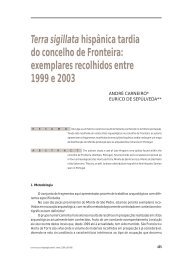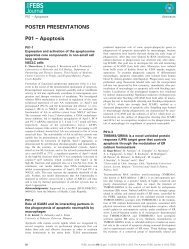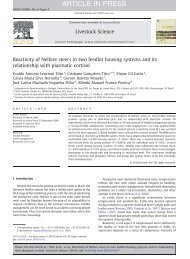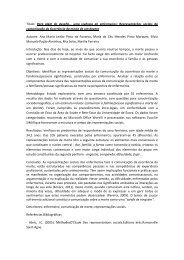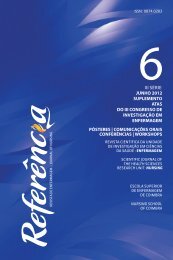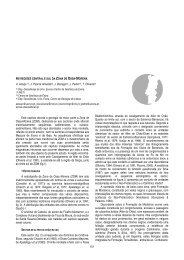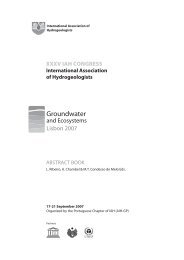- Page 3 and 4: João José Roma de Paços Pereira
- Page 5 and 6: “Quando há 20 anos nos surpreend
- Page 7 and 8: Resumo Observações preliminares e
- Page 9 and 10: - antes e depois do Verão. Em term
- Page 11: Abstract Preliminary observations a
- Page 15 and 16: Índice 1- Introdução geral .....
- Page 17: 5- Considerações finais .........
- Page 20 and 21: Situação mundial actual Actualmen
- Page 22 and 23: intertidal, a pesca à linha com ca
- Page 24 and 25: exploração humana de recursos viv
- Page 26 and 27: Impacte ecológico Com esta ausênc
- Page 28 and 29: 2000, 2003, com base em classifica
- Page 30 and 31: na Zona Económica Exclusiva portug
- Page 32 and 33: espectiva zona costeira, e tendo em
- Page 34 and 35: 2001, Martins, 1996, Franca e outro
- Page 36 and 37: comercial é, seguramente, o costei
- Page 38 and 39: Atendendo à presumível importânc
- Page 40 and 41: - apanha de isco (apanha intertidal
- Page 42 and 43: todo o litoral rochoso alentejano
- Page 44 and 45: inclui as praias de Cerro da Águia
- Page 46 and 47: Tabela 2.3- Delineamento da amostra
- Page 48 and 49: 2.3- Esta intensidade varia entre o
- Page 50 and 51: Tabela 2.6- Delineamento da amostra
- Page 52 and 53: situado acima da zona intertidal, e
- Page 54 and 55: 2.3- Resultados São em seguida apr
- Page 56 and 57: Tabela 2.8- Análises de variância
- Page 58 and 59: N.º pessoas/1km N.º pessoas/1km N
- Page 60 and 61: Em complemento ao estudo da questã
- Page 62 and 63:
N.º pessoas/1km N.º pessoas/1km N
- Page 64 and 65:
Tabela 2.13- Análise de variância
- Page 66 and 67:
Em complemento ao estudo da questã
- Page 68 and 69:
Tabela 2.15- Análises de variânci
- Page 70 and 71:
N.º pessoas/1km N.º pessoas/1km N
- Page 72 and 73:
Tabela 2.18- Testes SNK a factores
- Page 74 and 75:
- a variabilidade à escala da prai
- Page 76 and 77:
considerando esses factores ortogon
- Page 78 and 79:
Tabela 2.21- Análises de variânci
- Page 80 and 81:
Apanha de polvo e caranguejos Apanh
- Page 82 and 83:
N.º pessoas/1km N.º pessoas/1km N
- Page 84 and 85:
Tabela 2.25- Testes SNK a factores
- Page 86 and 87:
N.º pessoas/1km N.º pessoas/1km N
- Page 88 and 89:
Tabela 2.27- Análise de variância
- Page 90 and 91:
N.º pessoas/1km N.º pessoas/1km 6
- Page 92 and 93:
Tabela 2.29- Análise de variância
- Page 94 and 95:
Total global Predação (total) Mar
- Page 96 and 97:
N.º pessoas/1km N.º pessoas/1km 2
- Page 98 and 99:
N.º pessoas/1km N.º pessoas/1km N
- Page 100 and 101:
N.º pessoas/1km N.º pessoas/1km N
- Page 102 and 103:
Tabela 2.36- Análise de variância
- Page 104 and 105:
Tabela 2.38- Análise de variância
- Page 106 and 107:
- a maioria dos coeficientes obtido
- Page 108 and 109:
exercidas de modo regular, ao longo
- Page 110 and 111:
pela existência, no Verão, de um
- Page 112 and 113:
em litorais rochosos durante o Ver
- Page 114 and 115:
utilização destas praias arenosas
- Page 116 and 117:
trabalho, as capturas de ouriço-do
- Page 118 and 119:
Verão e Inverno no respeitante à
- Page 120 and 121:
detectada a mesma variação intera
- Page 122 and 123:
influência reflectiu-se no aumento
- Page 124 and 125:
observado foi de 247,3 apanhadores
- Page 126 and 127:
exploração do litoral é sobretud
- Page 128 and 129:
interagiram significativamente com
- Page 130 and 131:
do presente trabalho, é comum que,
- Page 132 and 133:
Tal como foi observado no presente
- Page 134 and 135:
do estado de agitação marítima,
- Page 136 and 137:
desta região, relativamente aos se
- Page 138 and 139:
este habitat é explorado por toda
- Page 140 and 141:
em actividades de pesca à linha, t
- Page 142 and 143:
presas (por exemplo, frestas ou ped
- Page 144 and 145:
informações previamente obtidas,
- Page 146 and 147:
umbilicalis, são mais abundantes e
- Page 148 and 149:
maiores (por exemplo, Carter, 1989;
- Page 150 and 151:
No entanto, outros factores poderã
- Page 152 and 153:
Na literatura consultada, não foi
- Page 154 and 155:
subsistência sido oficialmente rec
- Page 156 and 157:
outros factores, nomeadamente socia
- Page 158 and 159:
quantitativamente, de que as lapas,
- Page 160 and 161:
Tabela 2.43- Comparação de valore
- Page 162 and 163:
3- Rendimento e sustentabilidade da
- Page 164 and 165:
destes métodos, foi necessário co
- Page 166 and 167:
no respectivo recipiente de transpo
- Page 168 and 169:
3.2- As capturas efectuadas por dia
- Page 170 and 171:
para o porto de Sines publicadas na
- Page 172 and 173:
3.3- Resultados na secção 3.2. Re
- Page 174 and 175:
Tabela 3.1- Análises de variância
- Page 176 and 177:
Peso fresco (kg) 1 0.5 0 Apanha de
- Page 178 and 179:
Peso fresco (kg)/1km 7.5 5 2.5 0 Ap
- Page 180 and 181:
Tabela 3.6- Valores de peso (kg de
- Page 182 and 183:
3.3- As capturas efectuadas por pes
- Page 184 and 185:
Número de taxa 1 0 > intensidade <
- Page 186 and 187:
Sustentabilidade da predação huma
- Page 188 and 189:
Mediante amostragem destrutiva efec
- Page 190 and 191:
quatro datas na Primavera e no Outo
- Page 192 and 193:
Estes resultados sugerem que a expl
- Page 194 and 195:
apresentou uma elevada variabilidad
- Page 196 and 197:
com base numa amostragem mais direc
- Page 198 and 199:
Apesar de não ter sido observado u
- Page 200 and 201:
tem um papel mais activo na escolha
- Page 202 and 203:
apanha de percebe, relativamente à
- Page 204 and 205:
afloramento costeiro, como é o cas
- Page 206 and 207:
Considerando a totalidade da extens
- Page 208 and 209:
Por outro lado, a referida captura
- Page 210 and 211:
um stock subtidal não explorado ma
- Page 212 and 213:
produção de áreas “percebeiras
- Page 214 and 215:
Apanha de lapas Estado da exploraç
- Page 216 and 217:
Aumento potencial da intensidade de
- Page 218 and 219:
das principais espécies capturada
- Page 220 and 221:
Apesar da dispersão das larvas de
- Page 222 and 223:
observada em exemplares com sexo de
- Page 224 and 225:
atendendo à possibilidade de ocorr
- Page 226 and 227:
egistados por Thompson (1979): 2,0-
- Page 228 and 229:
Atendendo à maior dificuldade da a
- Page 230 and 231:
4- Impacte ecológico da predação
- Page 232 and 233:
orgânicos (Underwood, 1979; Branch
- Page 234 and 235:
por parte da maioria das lapas pres
- Page 236 and 237:
mantidos por entre uma turfa de alg
- Page 238 and 239:
4.2- Material e métodos Amostragem
- Page 240 and 241:
modo a aumentar o tempo disponível
- Page 242 and 243:
Colpomenia e os referidos anelídeo
- Page 244 and 245:
congeladas em sacos de plástico de
- Page 246 and 247:
vital, ou a área dos seus territó
- Page 248 and 249:
Tabela 4.4- Abundância (número de
- Page 250 and 251:
Tabela 4.5- Análises de variância
- Page 252 and 253:
análises da abundância de P. ulys
- Page 254 and 255:
N.º ind./50x50cm N.º ind./50x50cm
- Page 256 and 257:
Tabela 4.10- Testes SNK a factores
- Page 258 and 259:
N.º ind./0,25m 4 N.º ind./0,25m 4
- Page 260 and 261:
N.º ind./50x50cm N.º ind./0,25m 4
- Page 262 and 263:
N.º ind./0,25m 4 N.º ind./0,25m 4
- Page 264 and 265:
Tabela 4.15- Testes SNK a factores
- Page 266 and 267:
Tabela 4.16- Análises de variânci
- Page 268 and 269:
Tabela 4.18- ANOVA da variância po
- Page 270 and 271:
m 4 0.002 0.001 0 > intensidade < i
- Page 272 and 273:
N.º ind./1x2m N.º ind./1x2m N.º
- Page 274 and 275:
Tabela 4.23- Testes SNK a factores
- Page 276 and 277:
N.º ind./cm 2 N.º ind./cm 2 0.2 0
- Page 278 and 279:
Tabela 4.26- Testes SNK a factores
- Page 280 and 281:
cm 2 cm 2 cm 2 100 50 6 4 2 0 0 100
- Page 282 and 283:
Tabela 4.28- Testes SNK a factores
- Page 284 and 285:
% Algas encrustantes moles % 10000
- Page 286 and 287:
Tabela 4.30- Testes SNK a factores
- Page 288 and 289:
- nas poucas análises em que os tr
- Page 290 and 291:
Tabela 4.32- Testes ANOSIM a dois f
- Page 292 and 293:
Tabela 4.33- Testes ANOSIM a dois f
- Page 294 and 295:
esperado no caso do impacte da expl
- Page 296 and 297:
da maioria dos substratos duros int
- Page 298 and 299:
além destas lapas de tamanho grand
- Page 300 and 301:
2000; Boaventura e outros, 2002a).
- Page 302 and 303:
folhosas, que impedem a adesão das
- Page 304 and 305:
que o factor remoção foi signific
- Page 306 and 307:
exemplo, de Corallina officinalis,
- Page 308 and 309:
cobertura do espaço primário, o q
- Page 310 and 311:
territórios, é provável que a pe
- Page 312 and 313:
pequenos de Patella tivesse sido me
- Page 314 and 315:
De qualquer modo, os principais efe
- Page 316 and 317:
zona central; Dethier, 1994) e, por
- Page 318 and 319:
verrucosa, tendo sido Ralfsia um do
- Page 320 and 321:
1992). Por outro lado, segundo os m
- Page 322 and 323:
Interacções negativas e positivas
- Page 324 and 325:
quadrados, à área, que totalizou
- Page 326 and 327:
5- Considerações finais Relaçõe
- Page 328 and 329:
Porém, os impactos humanos não es
- Page 330 and 331:
e a apanha de algas e mariscos em f
- Page 332 and 333:
como acima foi referido, mas sobret
- Page 334 and 335:
tendem a ser imprevisíveis, tanto
- Page 336 and 337:
6- Literatura citada Adão, MH, 200
- Page 338 and 339:
Branch, GM e MI Cherry, 1985. Activ
- Page 340 and 341:
Connell, JH e MJ Keough, 1985. Dist
- Page 342 and 343:
Fischer-Piette, E, 1941. Croissance
- Page 344 and 345:
Hockey, PAR, AL Bosman e WR Siegfri
- Page 346 and 347:
McLachlan, A, JE Dugan, O Defeo, AD
- Page 348 and 349:
Rius, M e HN Cabral, em publicaçã
- Page 350 and 351:
Thompson, RC, TP Crowe e SJ Hawkins
- Page 352 and 353:
7- Anexos 7.1- Actividades de preda
- Page 354 and 355:
- a fisga, para a captura de choco
- Page 356 and 357:
A apanha de lapas e burriés parece
- Page 358 and 359:
tendo as zonas mais exploradas melh
- Page 360 and 361:
- entre 1990 e 2003, o número tota
- Page 362 and 363:
- em média, os desembarques anuais
- Page 364 and 365:
Tabela 7.1- Distribuição de frequ
- Page 366 and 367:
Nestes períodos, a percentagem de



